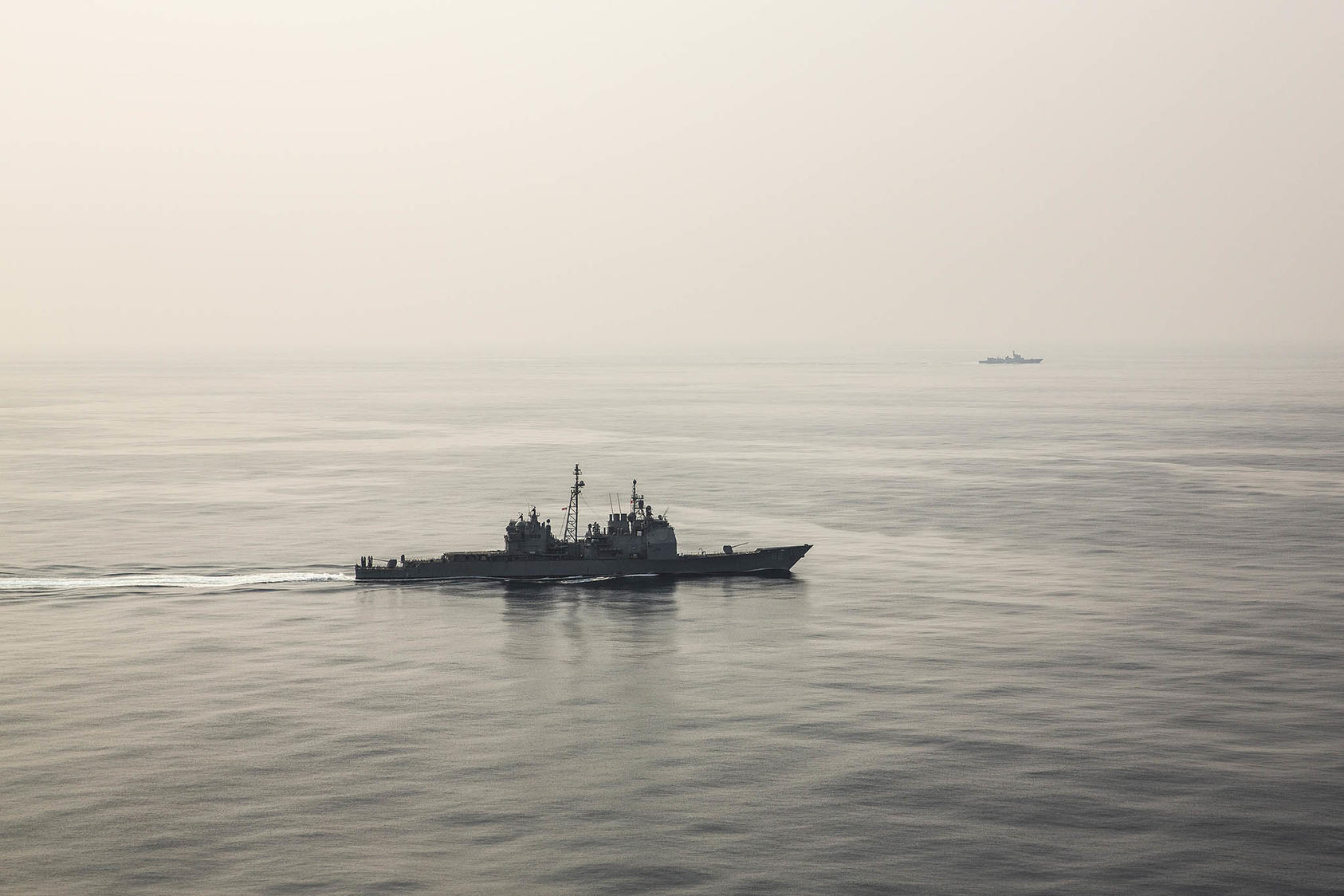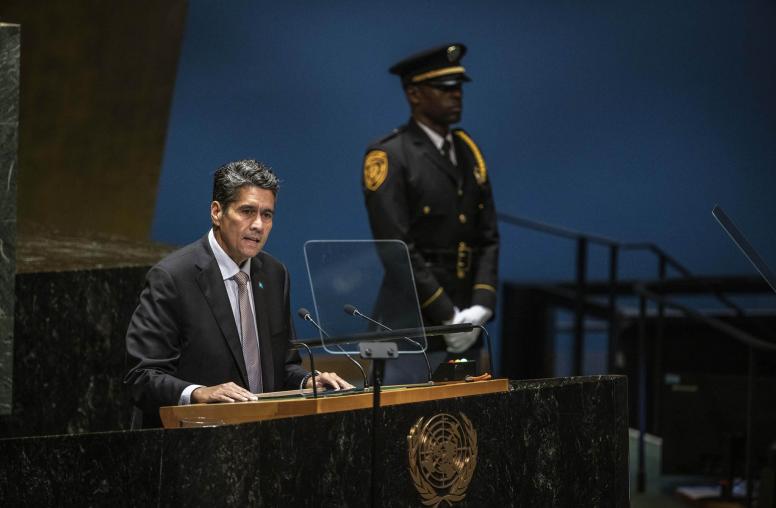China’s Search for a Permanent Military Presence in the Pacific Islands
After the Solomon Islands signed a security pact with Beijing in April, Kiribati may be considering a similar deal.
In April, China signed an unprecedented security pact with the Solomon Islands, sparking regional concerns of a future Chinese military presence there. China’s pursuit of greater military reach in the Pacific Islands draws parallels to Imperial Japan’s construction of bases prior to World War II, and the implications are, likewise, strikingly similar. A Chinese military presence in the Pacific Islands could complicate transit between Australia and the United States, allow Beijing to increase its power projection in the second and third island chains, and bring Chinese military firepower closer than ever to Australian and U.S. territory. Can the United States and its partners prevent such an outcome?

China Has Quietly Sought a Military Outpost in the Pacific Islands For Years
While China has many interests in the Pacific Islands and has cultivated diplomatic and economic ties with them for decades, Beijing’s interests in the region are also inherently strategic.
In 2018, Australian press reported that China had requested the right to establish a permanent military presence in Vanuatu, which is less than 2,000 kilometers from Australian territory — although no formal agreement had been drafted.
In an attempt to assuage local and international concern, then-Prime Minister of Vanuatu Charlot Salwai publicly promised there would be no Chinese military presence and denied that any such talks had taken place. Under fire for his past receptivity to China, Salwai may have seen acquiescing to Beijing as too great a political risk.
Later the same year, an Australian press report outlined China’s interest in refurbishing a port on Manus Island in Papua New Guinea, the site of an Allied naval base during World War II. But the Papua New Guinea government turned to Australia and the United States to redevelop the port instead, showing a greater willingness to trust traditional partners on security matters.
Beijing was once again forced to look elsewhere.
The Solomon Islands — which stretches between Papua New Guinea and Vanuatu and hosted key air and naval bases during World War II — was the next logical target. After the Solomon Islands switched diplomatic recognition from Taipei to Beijing in 2019, China could pursue security engagement there directly.
Beijing Is Adapting Its Strategy and Finding More Willing Partners
As China casts a wider net in pursuit of a military foothold, its approach has also changed. Chinese leaders have learned that Pacific Island countries are more receptive to security agreements that downplay Beijing’s military aims and offer specific benefits in return. Such a calculation likely shaped the China-Solomon Islands security pact — and it worked.
The pact grants permission for the Chinese navy to dock and replenish in the Solomon Islands, laying the groundwork for a facility that could be expanded over time. China likely aims to establish a permanent military presence, but will do so in a way that allows the two sides to deny that it is a base.
This resembles the U.S. approach to its force posture in Asia in recent decades, where the United States has pursued access agreements and rotational deployments, not fixed bases. It also mimics China’s approach in Cambodia, where Beijing denies it is establishing a base but its plan for a regular presence is clear.
Meanwhile, China’s stated aims of maintaining stability and protecting Chinese businesses in the Solomon Islands give Beijing plausible deniability for signing the agreement.
The pact allows the Solomon Islands to seek assistance from Chinese security forces to maintain social order — likely an attractive prospect for Solomon Islands Prime Minister Manasseh Sogavare after the country was shaken by days of deadly unrest in November. Beijing found a receptive partner in Sogavare, a risk-taker who hasn’t been afraid to draw domestic criticism over his growing relationship with China.
Of course, the prospect of Chinese security forces deploying to the Solomon Islands caused an outcry among citizens. Much of the country’s unrest in recent years has been fueled by local dissatisfaction over the government’s growing relationship with Beijing, which belies the idea that Chinese police could ever act as a stabilizing force. But for Sogavare, increased Chinese police engagement may be less about keeping the peace and more about cracking down on his political opponents.
The signing of the pact also caused concern across the region, prompting Sogavare to reassure leaders at the Pacific Islands Forum (PIF) last week that he would not allow a Chinese military facility. But in a country as prone to corruption and frequent leadership turnover as the Solomon Islands, his promise is not reassuring, and China may find an even more receptive partner than Sogavare in the future.
China’s Next Move
In March, the China-Solomon Islands security pact was leaked to the press while it was still a draft, increasing the likelihood that China will be even more secretive going forward.
But Beijing is unlikely to abandon its pursuit of a military presence, especially in the southwest Pacific. China will likely continue its outreach in the Solomon Islands, and may revisit Vanuatu and Papua New Guinea.
No part of the region should be overlooked. Bougainville, an autonomous region in Papua New Guinea, is seeking to gain independence by 2027. If Bougainville can gain greater autonomy or full sovereignty, in particular control over its own defense (outcomes which are by no means assured), it, too, could become a target for China’s strategic ambitions.
Meanwhile, China has most likely expanded its search for a potential military facility to include the broader Pacific region.
Last year, China drafted plans to upgrade a U.S.-built World War II-era runway on Canton Island, Kiribati. Beijing claimed that the project was not military in nature. But a potential Chinese military presence so close to Hawai’i would present unique challenges for the United States.
In 1979, the United States and Kiribati signed the Treaty of Tarawa, which requires that facilities constructed by the United States “shall not be made available to third parties for military purposes,” and both countries shall consult on “any military use by third parties” of islands named in the treaty, including Canton.
But the treaty does not give Washington the right to deny foreign military access entirely, and enforcing it would depend on political will on both sides of a relationship that is far from close. China could easily sidestep the treaty by constructing its own facilities, if Beijing can persuade Kiribati to agree.
Like Sogavare, Kiribati President Taneti Maamau presided over a controversial switch in diplomatic relations from Taipei to Beijing in 2019. And like Sogavare, Maamau drew domestic criticism for the decision, but has managed to weather it so far.
Now, former Kiribati President Anote Tong believes that Maamau may be discussing a security deal with China similar to the Solomon Islands pact. In May, Maamau signed multiple agreements to work more closely with Beijing during Chinese Foreign Minister Wang Yi’s tour of the region. Kiribati is struggling with the impacts of climate change, COVID-19 and a poor economy — giving China multiple leverage points.
Moreover, Kiribati has shown a willingness to break with regional partners, withdrawing from the PIF this month over concerns of unequal representation even as several other Micronesian countries rejoined the forum. Regional leaders are seeking a resolution, but that could take months or even a year.
Sogavare probably felt pressure from his fellow PIF members to promise that there would be no Chinese military presence in his country. However, Maamau — severed from the forum and the region, at least for now — may not feel that same pressure.
How Can China’s Militarization of the Pacific Islands Be Prevented?
Many Pacific Islanders see a potential Chinese military presence as a threat to the stability of the region and worry about being drawn into U.S.-China competition, or even a future war. This suggests that public exposure of China’s plans for military outposts in the region would be a setback for Beijing.
But exposing China’s plans requires timely and accurate information, and it isn’t a failsafe approach, as the Solomon Islands has shown. The leak didn’t stop the security pact from being signed, and domestic criticism doesn’t seem to have deterred Sogavare — although next year’s elections may tell a different story.
For the United States and its partners to prevent China from militarizing the region, they will need to dissuade Pacific Island countries from signing security pacts with Beijing. But not even Australia, the Solomon Islands’ longstanding security partner, could discourage Sogavare from signing the pact, and the United States arrived too late.
The agency of the Pacific Islands themselves should not be overlooked. Regional leaders, because of their close ties to each other, probably have more power than Washington to influence their counterparts. At the PIF, leaders discussed the possibility of consulting with each other before entering into security arrangements.
If the United States is to preclude another Chinese security pact in the future, Washington must work hard to build trust and mutually beneficial relationships with the Pacific Islands after decades of neglect. The Pacific Islands have more choices for partnerships than ever. Therefore, cultivating relationships with them will be crucial if the United States is to be the partner of choice.
First and foremost, the United States must expand its diplomatic presence, starting by following through on announced plans to establish three new U.S. embassies in the region — in the Solomon Islands, Kiribati, and Tonga. Only through regular presence will the United States be able to forge substantive, long-term relationships, which must also be supported by high-level visits, increased aid and other initiatives.
As the White House develops its first national strategy for the Pacific Islands in the coming months, it has the opportunity to chart a new course that puts in place the fundamental building blocks for engaging with the Pacific Islands over the long term, just like other regions critical to U.S. national interests.



